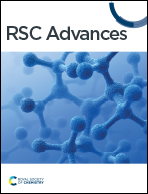Photoacoustic detection of transient phase transformation of nanoparticles†
Abstract
The controllable preparation of spherical micro/nano particles of various materials has been achieved via the technology of the laser synthesis and processing of colloids (LSPC) recently. However, there is limited in situ research on the evolution processes of nanoparticles in photothermal transient environments, such as solid-state crystal transformations and changes of state, which limits the understanding and application of LSPC. Photoacoustic (PA) signals are sensitive to the optical, thermal and elastic properties of the medium, and can be used to measure the thermal and spectroscopic properties of matter. In this paper, the PA signals generated by the interaction of the laser with the surrounding liquid medium (ethanol, water, glycerin, etc.) and nanoparticles (Ag, TiO2, CeO2, ZrO2, etc.) are studied when the tunable LSPC technique provides different photothermal conditions (such as thermal expansion, solid crystal transformation and evaporation). It is found that semiconductors with different bandgaps, as light absorbers, have the ability to selectively absorb laser beams of different wavelengths. By changing the wavelength, the PA intensity can be adjusted accordingly. In addition, based on the fast laser heating and tunable fluence characteristics of non-focused laser beams in LSPC technology, transient processes such as material phase transitions and changes of state can be excited separately by adjusting the laser fluence. Taking titanium dioxide as an example, the PA signals generated by laser selective excitation of A–R (anatase into rutile) phase transitions and rutile vaporization can be detected.



 Please wait while we load your content...
Please wait while we load your content...